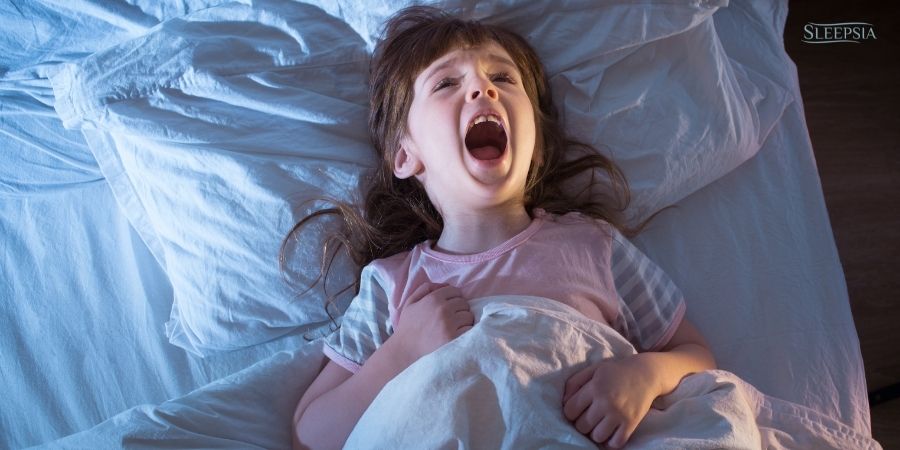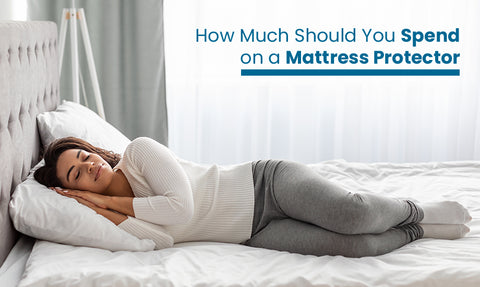
Causing intense fear at night, especially in children, night terrors, although different from nightmares, can distress a person and his or her family.
As no proper diagnosis exists, doctors have to rely on the experiences of the patient and devise a treatment plan accordingly.
In this post, you’ll learn more about night terrors, its symptoms, and treatment and management options.
What are night terrors?
Night terrors cause episodes that distress and scare an individual during their sleep. When a person experiences an episode of night terror, he or she generally flails their limbs around and sharts shouting suddenly.
According to Mayo Clinic, a night terror episode generally lasts from seconds to a few minutes, but in rare instances, it may last for longer.
Night terrors affect an estimated 40 percent of children, but a relatively smaller number of adults.
Symptoms of night terror
As they differ from nightmares, people experiencing night terrors generally can’t wake up and tend to stay asleep through the episode.
While nightmares occur during the rapid eye movement (REM) sleep, night terrors occur during the first-third of the sleep, aka slow-wave sleep.
Signs that a person is experiencing night terrors may include:
- Thrashing and flailing limbs
- Shouting and screaming
- Sleepwalking
- Sitting up abruptly in bed
- Enhanced muscle tone
- Confusion upon waking
- Forgetting the terrifying event
- Heavy breathing and sweating
- Racing pulse
Usually, the more terrifying the dream, the less likely a person is to remember it upon waking up.
At what age do night terrors stop?
Night terrors don’t specifically end at a particular age. But they do tend to peak at around 18 months of age. And as the nervous system of a child develops, night terrors generally disappear.
Causes of night terror
Night terror can be caused by the following factors:
- Stress and anxiety
- Fever
- Sleep deprivation
- Sleep disorders, such as insomnia
- Migraine headaches
- Genetics
- Drug abuse
Bullied children are more than twice as likely to experience night terrors.
Teenagers may develop night terrors because of psychiatric disorders or truma.
Night terrors are often associated with the following medical conditions:
- Restless legs syndrome
- Generalized anxiety disorder
- Migraine headaches
- Sleep apnea
- Parkinson’s disease
Certain medications may induce night terrors.
Also, the following factors may play a role in inducing night terrors:
Genetic factors
Genetics can play a huge role in both sleepwalking and night terrors.
According to a study conducted in 1980, 96 percent of people with night terrors have at least one other close family member who experiences night terrors, sleepwalking, or both.
Sleepwalking
There seems to be a nexus between sleepwalking and night terrors, as both occur when the person is in the slow-wave (first-third) of the sleep cycle.
Slow-wake sleep is considered the deepest stage of sleep before the REM sleep begins. According to researchers, people who sleepwalk or experience night terrors may have problems with slow-wave sleep.
As sleep problems make them more prone to waking up at night, it increases their likelihood of developing disruptive sleep-related disorders (parasomnias.)
Thalamic dysfunction
Thalamus is the part of the brain that translates neural impulses to the cerebral cortex. Since thalamus plays a major role in processing sensory information, dysfunctions related to it may cause night terrors.
However, night terrors because of thalamus dysfunction are rare.
Night terrors in adults
Adults are more likely to suffer from night terrors if they’ve a medical history of:
- Anxiety
- Depression
- Bipolar disorder
But the incidence rate of night terrors in adults is very low, especially in people over the age of 65.
Diagnosis of night terrors
According to DSM V, no particular diagnosis exists for night terrors. So the doctor will rely on patients' experiences, past medical history, and family’s medical history.
According to the reports, the doctor may prescribe physical or psychological tests, if appropriate.
Sleep study
Your doctor may prescribe a sleep study (polysomnography), which requires you to spend an entire night at a sleep laboratory.
While you sleep, machines record your brain activity, breathing, heart rate, eye movement, and blood oxygen levels.
The doctor will correlate the results of your sleep study with other tests and then make a diagnosis.
If you suffer from night terrors, then your sleep study may reveal abnormal breathing, sometimes along with sleep apnea or restless legs syndrome.
Treatment for night terrors
Although night terrors are scary and distressing, they’re unlikely to cause any permanent damage to children and adults. Further, the episodes pass without any intervention and even stop occurring altogether.
However, if you believe that night terrors are having a significant effect on you or your child, then treatment may be necessary.
Here are the three types of treatment options available:
- Techniques to deal with stress
- Relaxation techniques
- Counselling
- Psychotherapy
- Medications
- SSRI (serotonin reuptake inhibitor) antidepressants
- Benzodiazepines
- Treatment of underlying medical conditions, such as depression or sleep apnea.
Management of night terrors
While you should get a diagnosis from a certified medical processional, you may also want to try a number of management techniques mentioned below:
Relaxation techniques
Relaxation techniques help to calm your nerves. If you’re regularly stressed out or anxious, then these techniques will provide you relief.
You should pick one or two of these techniques and practice them multiple times a day.
Here are a few relaxation techniques that you can practice anytime, anywhere:
4-7-8 breathing technique
Invented by Dr. Andrew Weil, 4-7-8 breathing technique requires you to control your breathing to relax your mind.
As a relaxation technique, it is often used to induce sleep quickly. While many other breathing techniques exist, this one seems to be better at calming down the nerves.
Many people cannot sleep properly because they’re bombarded by thoughts that increase anxiety, which activates the brain and promotes wakefulness. As you count and control your breath, this technique makes you forget about your anxiety inducing thoughts.
Steps to practice the 4-7-8 breathing technique:
- Lie down or sit in a comfortable position.
- Inhale for 4 seconds.
- Hold your breath for the next 7 seconds.
- Release the breath for the next 8 seconds.
- Repeat until you’re relaxed or fall asleep.
We recommend that you practice this technique several times during the day in order to get used to it. Because your mind will still wander, you need to develop a habit of controlled breathing to ease your stress and anxiety.
Grounding
Simply sensing your environment with various sense organs can calm your mind. When you take in different aspects of your environment, your mind recognizes that there’s no imminent danger and your anxiety disappears.
To practice the grounding technique, you can follow the steps provided below:
- Take in a few deep breaths to calm your mind.
- See five things around you, one at a time, and notice their properties: color, shape, size, etc.
- Recognize 4 different sounds around you.
- Touch three different things around you. Notice the texture of each of these things.
- Smell two things.
- Remember the taste of your favorite food.
Once you’ve gone through the whole process, your mind will be completely calm, and you won’t experience anxiety, until you start pondering on your thoughts. This is where you need to be mindful.
Note: if you’ve just experienced a night terror, then you can use grounding to calm down and decrease the stress.
Mindfulness
Mindfulness meditation is a simple way to learn to not judge your thoughts. Thoughts are going to cross your mind, no matter what you do.
And if you judge those thoughts, then you go into a cycle, in which one thought leads to another.
To practice mindfulness, follow the steps given below:
- Sit or lay down in a comfortable position
- Focus on your breathing.
- Thoughts will come up in your mind. Simply note them and move your focus back to your breath.
Many people get frustrated because they can’t maintain focus on their breath for too long. But you need to remember that focus is a muscle, and you need to build it up.
Simply practice mindfulness meditation daily, and overtime, you’ll improve and learn not to judge your thoughts.
Journal
Simply jotting down your thoughts can decrease your anxiety. When we avoid thoughts, they don’t generally disappear. So you can note down your thoughts and find their inception point to resolve the anxiety permanently.
In fact, once you recognize a problem, you should note it down again and again, day after day, to increase your awareness of that problem.
Sleep more
If you’re feeling sleepy throughout the day, then you may need more sleep. Since sleep deprivation can cause night terrors, you should be getting good quality sleep that leaves you energized upon waking up.
Even though the general recommendation is to get a minimum of 6 hours of sleep, the actual amount required to feel completely rested differs from person to person.
So you should aim for a sleep of 7 to 9 hours, or even more if your body demands it.
If you still feel drowsy during the day, then you should consult a certified medical professional, as excessive daytime sleepiness may be a sign of an underlying medical condition.
Create an ideal sleep environment
Experiencing episodes of night terror may be bad enough. You don’t want to complement them with sleep disorders, such as insomnia.
Your sleep environment determines the quality and quantity of the sleep that you get. So here are a few tips to help you optimize your sleep environment:
- Purchase suitable pillows and mattresses: type of mattress and the size of pillow largely depends upon your sleeping position and body type.
- Lower the thermostat: cooler environments promote sleep, while the hot and humid ones wake you up.
- Drown out the noise: use earplugs or white noise machines to drown out the noise from your environment.
- Dim the lights: our circadian rhythm (sleep-wake cycle) is largely dependent upon the light signals received from the eyes. So dim the lights to get good quality sleep.
Sleep hygiene
Even though you may sleep for the required hours, you may still feel drowsy because of low quality sleep, which is defined by constant interruptions.
That’s why it is essential to follow good sleep hygiene.
To follow good sleep hygiene, you can employ the following tips:
- Maintain a constant schedule: consistently sleep and wake up at same times to ensure that your body gets into the habit of releasing melatonin at a particular time before you head to bed.
- Follow a night routine: a relaxing night routine should consist of journaling, relaxation techniques, and some light reading. You can also listen to podcasts.
- Avoid electronic devices close to bedtime: avoid using smartphones and laptops at least an hour before you head to bed. These devices emit blue light, which promotes alertness and impedes the release of melatonin.
- Avoid stimulants: don’t drink coffee for at least 6 hours before going to bed. Caffeine has a half life of 6 hours, so it tends to stay in your bloodstream for a long amount of time.
Read more about sleep hygiene.
Exercise regularly
If you tire out your body during the day, you’ll find it easier to fall asleep at night. However, to gain sleep related benefits, you must exercise for at least 30 minutes per day.
Even though you may not have enough time to hit the gym, you can workout at home. In fact, here are a few at home workouts that you may use to tire out your body:
Sleep journal
When you regularly track your sleep, you become aware of the patterns that are decreasing the quality and quantity of it.
In your sleep journal, you should ideally record the following:
- Amount of time you sleep
- Time at which you went to sleep
- Time at which you woke up
- Daily exercise
- Amount of coffee consumed
- Amount of alcohol consumed
- Thoughts that occured while you tried to sleep
Conclusion
Night terrors are frightening indeed. They stress you out and leave you anxious. Further, they can cause serious mental health problems, such as depression. So get a diagnosis from a certified medical professional and employ the tips mentioned in this article to improve both your sleep and your life.












